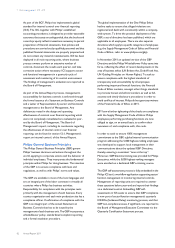Philips 2011 Annual Report Download - page 74
Download and view the complete annual report
Please find page 74 of the 2011 Philips annual report below. You can navigate through the pages in the report by either clicking on the pages listed below, or by using the keyword search tool below to find specific information within the annual report.
6 Sector performance 6.3.3 - 6.3.4
74 Annual Report 2011
Total sales by business 2011
as a %
Lamps
41
Packaged LEDs/
LED solutions
6
Professional
Luminaires
26
Consumer
Luminaires
5
Automotive
Lighting
8
Lighting Systems & Controls
14
The Lamps business conducts its sales and marketing
activities through the professional, OEM and consumer
channels, the latter also being used by our Consumer
Luminaires business. Professional Luminaires is organized
in a trade business (commodity products) and a project
solutions business (project luminaires, systems and
services). For the latter, the main focus is on specifiers,
lighting designers, architects and urban planners.
Automotive Lighting is organized in two businesses: OEM
and After-market. Lighting Systems & Controls and
Special Lighting Applications conduct their sales and
marketing through both the OEM and professional
channels.
The conventional lamps industry is highly consolidated,
with GE and Siemens/Osram as key competitors. The LED
lamps industry is in its early days, with a variety of
competitors entering the marketplace. The luminaires
industry is fragmented, with our competition varying per
region and per segment. Our Lighting Systems & Controls
and Automotive Lighting businesses operate in more
consolidated market sectors. In the world of digital
lighting, a wide range of new entrants are active in the
transitions to LED lighting and to applications and
solutions.
Philips Lighting has manufacturing facilities in some 25
countries in all regions of the world and sales
organizations in more than 60 countries. Commercial
activities in other countries are handled via dealers
working with our International Sales organization. Lighting
has approximately 53,000 employees worldwide.
Lighting is subject to significant regulatory requirements
in the markets where it operates. These include the
European Union’s Waste from Electrical and Electronic
Equipment (WEEE), Restriction of Hazardous Substances
(RoHS), Energy-using Products (EuP) and Energy
Performance of Buildings (EPBD) directives.
With regard to sourcing, please refer to sub-section 5.3.3,
Supply management, of this Annual Report.
6.3.4 Progress against targets
The Annual Report 2010 set out a number of key targets
for Philips Lighting in 2011. In the course of the year,
reflecting the evolving business reality and the adoption
of Accelerate!, these were encapsulated in four key
“sector acceleration trajectories” designed to improve
profitability on the path to LED and solutions – and to
achieve our mid-term targets. The progress made in
addressing these trajectories is outlined below.
Accelerate transformation to LED,
applications and solutions
In 2011 we further strengthened our expertise in LED
development and application. Our LED-based sales grew
by 30% compared to 2010, representing some 16% of
total Lighting sales. Sales growth of LED-based lamps and
luminaires was approximately 70%. To retain our
leadership position we invested in optimizing lamp
performance and lifecycle, and in expanding our portfolio
of leading LED solutions in professional segments such as
outdoor, office and retail, and in the automotive and home
segments. Our leadership position in LED lamps was
underlined by our winning the US Department of Energy’s
coveted L Prize for the first 60 W replacement LED lamp.
Our sales of solutions (luminaires, controls, software and
services) grew by 50% in 2011. We continued to invest in
growing our solutions business. We hired new key
account managers in nearly all our markets and staffed our
Turn-Key Projects & Solutions teams, both on a global and
a market level. We launched Lighting Capital – a payment
program that enables customers to acquire lighting
solutions without an upfront capital investment – and
developed several service propositions besides system
solutions such as Lumimotion, in which we combine
hardware with controls and software to act as a smart
system. The acquisitions of Optimum and Indal will
strengthen our solutions business.
Strengthen performance management and
execution
We are implementing the Accelerate! program to further
gear up our organization to take full advantage of the LED-
driven future opportunities in the lighting industry. We
are connecting business and market teams through our
so-called BMC (Business/Market Combination) approach
to win customers in key markets, reduce complexity,
improve execution along our end-to-end customer value
chain, and increase speed to market – all with the aim of
driving market leadership, accelerating growth and
boosting profitability.
























